In 1976 an unexpectedly beautiful creature emerged from a theoretical study of 2D crystals in a magnetic field. With its repeating recursive flutter of wings, ‘Hofstadter’s butterfly’ showed how the effects of an applied magnetic field and the electrostatic potential from a two-dimensional crystalline lattice play out, and would help explain electron behaviour in various quantum systems.
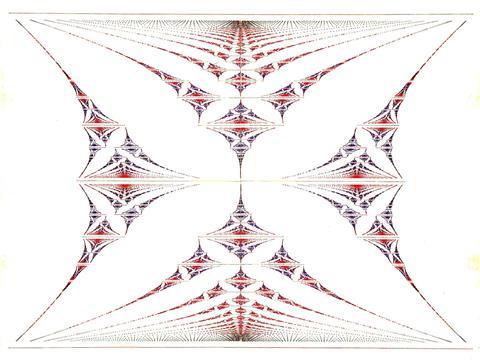
Yet for almost forty years it remained a figment of theory, until a flurry of experiments with graphene – honeycomb sheets of carbon atoms – layered on boron nitride revealed the butterfly in experimental data for the first time. Ten years later another series of experiments – two observing the Hofstadter butterfly and one further exploiting the effects that brought it into view experimentally – have highlighted the vast scope that layered 2D material systems can explore, further blurring the boundary between two and three dimensions, and even the distinction between periodic and aperiodic structures.
Butterflies and ‘magic’ moiré structures
The rich electron spectra of the Hofstadter butterfly emerges when the ‘Lorentz force’ that acts on an electron moving in a magnetic field drawing it towards circular paths, is overlaid with the Coulomb potential from a periodic crystal lattice. The quantum Hall effect – the discrete increases in resistance incurred in a 2D material with an increasing magnetic field – is now attributed to the same phenomena. The deviations in the electron paths to accommodate quantised cyclotron orbits manifest as increased resistance.
The main challenge for efforts to reveal the Hofstadter butterfly spectra in experimental data was the enormous magnetic field required to match the scale of the periodicity in an atomic lattice – billions of times stronger than the Earth’s magnetic field, and far beyond the reach of experimental setups. The coup came with the arrival of wonder material graphene, and studies of its electron behaviour on similarly two-dimensional hexagonal boron nitride (hBN). The hBN lattice is 2% bigger than graphene’s, so putting the two together gives a similar effect to that seen in moiré fabrics when the mesh of two textiles is out of sync. What the dizzy eye beholds is a material pattern with a much larger periodicity depending on how the fabric layers are aligned. Similarly electrons in these moiré materials are subject to a larger lattice with a periodicity that can be in the realm of tens of nanometres – well-suited for observing the Hofstadter butterfly.
Theory also predicted that under the influence of these larger moiré superlattices, at certain ‘magic angles’, graphene’s headline-grabbing whizzy electrons would effectively grind to a halt. With zero kinetic energy their behaviour is then governed almost exclusively by Coulomb interactions with other electrons, rendering strongly correlated electron effects like superconductivity. In 2018 teams led by Pablo Jarillo-Herrero from the Massachusetts Institute of Technology (MIT), US, produced bilayer graphene structures twisted at these magic angles and used gates to tune between such superconducting and, at the other extreme, insulating states. From there studies on moiré materials exploded, looking at more layers, different 2D materials such as transition metal dichalcogenides, and finding more and more examples of correlated electron effects and superconductivity. There was even hope that a route to room-temperature superconductivity might be found through this line of research, although a definitive explanation of the origins of superconductivity in these systems remains debated.
Moiré quasicrystals
In their latest project, Jarillo-Herrero and his collaborators set out to investigate a twisted structure of three graphene layers, where the top and bottom layer are effectively aligned but the middle layer is twisted out of sync by a magic angle. However, the team had accidentally produced a structure where the top and bottom layer were offset with each other as well as with the middle layer, which led to initially unfathomable traits in the data.1
‘We were puzzled,’ says MIT’s Aviram Uri, who helped lead the work. After six months of chipping away at the problem they realised that with the bottom and middle layer creating one moiré lattice and the middle and top layer creating another slightly different moiré lattice, the two moiré lattices combined were producing a pattern that didn’t ever quite repeat – a quasicrystal. ‘When we realised we had a quasicrystal it was quite exciting, actually,’ adds Uri.
The concept of quasicrystals was first introduced by Paul Steinhardt, now a physics professor at Princeton and his then student Dov Levine in 1984. Quasicrystal patterns comprise subgroups with different repeating rates such that the ratio between the rates is an irrational number, and the combined pattern never repeats. ‘That is like a disharmony in space,’ Steinhardt tells Chemistry World.
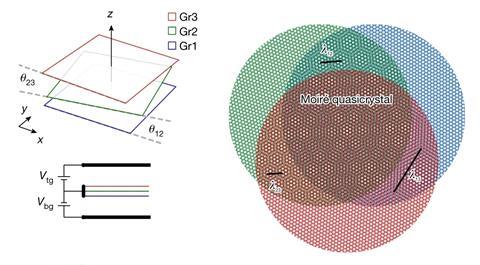
MIT’s Mallika Randeria and Daniel Rodan Legrain also helped lead the project alongside Sergio de la Barrera, now based at the University of Toronto, Canada. De la Barrera points out that most 2D material systems layered out of sync will produce a quasicrystal, and in fact Steinhardt and Levine had flagged the potential of moiré crystals in quasicrystal research in 1986. However, de la Barrera suggests that often the scale of these features is too small to be ‘relevant’ to electrons.
While a lot of research has explored the types of atomic quasicrystalline structures that could exist and the distinctive physical properties they might have, the impact of this quasicrystal background on electron behaviour has been hard to pin down. Theoretical studies hit problems because most calculations of electronic behaviour assume a periodicity, which is compromised in a quasicrystal lattice, while experimentally the effects of defects can be hard to distinguish from those of the quasicrystal characteristics.
Uri suggests another potential challenge, as he tells Chemistry World: ‘In atomic quasicrystals, electrons [at energies] that are accessible to transport measurements often do not respond significantly to the quasicrystal landscape.’ However, the electrons ‘cannot ignore it at all’ in the quasicrystal he and his collaborators had stumbled on because the size of the features was just that much bigger.
‘It will be fascinating to learn if these produce interesting, distinctive and even useful patterns,’ says Steinhardt.
With their double moiré quasicrystal, Jarillo-Herrero’s team was able to observe all kinds of eccentric electron behaviour, including superconductivity. Uri suggests the structures can be considered analogous to those rendering Hofstadter’s butterfly but with the second fixed moiré lattice potential supplying the secondary structure the electrons are subject to, rather than a tunable magnetic field. Indeed calculations for the moiré quasicrystal reveal electron characteristics like those found in the Hofstadter butterfly too.
Whereas traditional quasicrystals are tough to engineer with bespoke features, the behaviour of the moiré quasicrystals is readily tuned not just by adjusting the twists but also by applying voltages and low magnetic fields. They could even coax the same structure to behave either as a crystal or as a quasicrystal in terms of its electronic properties. ‘It is kind of leaving the paradigm of something being a quasicrystal or not,’ says de la Barrera. It is not the only distinction made fluid by moiré material research.
Hybrid dimensions
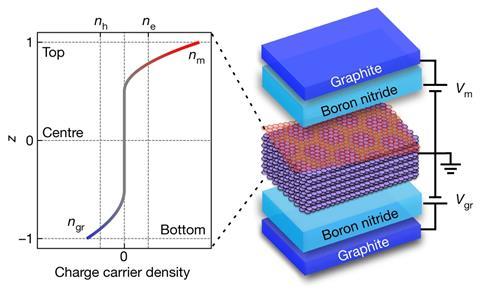
‘Over the past couple of years my group have been focusing on trying to understand something more universal about what might happen with these structures that have a single twisted interface,’ explains Matthew Yankowitz, a condensed matter physicist at the University of Washington, US. They eventually created a twist in a thin film of graphite – a 3D material – with a view to gradually reducing the thickness to the 2D material regime to see how the moiré characteristics emerged during the transition. Although the strongly correlated states were gone in the twisted graphite, the electron behaviour was dramatically altered by the twisted interface forming a hybrid 2D–3D structure.2
Although the physical mechanisms are still a little unclear, in hindsight Yankowitz suggests this should not have been such a surprise. The quantum Hall effect was reported in graphite in 2019 by Artem Mishchenko, Vladimir Fal’ko and graphene Nobel laureate Andre Geim at the University of Manchester and their collaborators. It was dubbed the ‘2.5-dimensional quantum Hall effect’ because the effect had always been considered fundamentally 2D, but the Manchester researchers explained its presence in graphite in terms of electrons moving in spirals between the top and bottom interfaces in a standing wave, rather than flat circles. In their twisted graphite Yankowitz and his team reported observations of the quantum Hall effect and the Hofstadter butterfly as well. ‘What our work did was basically to exploit this standing wave to now couple the twisted interface to the bulk,’ says Yankowitz, who suggests other surface properties might be drawn into the bulk in the same way.
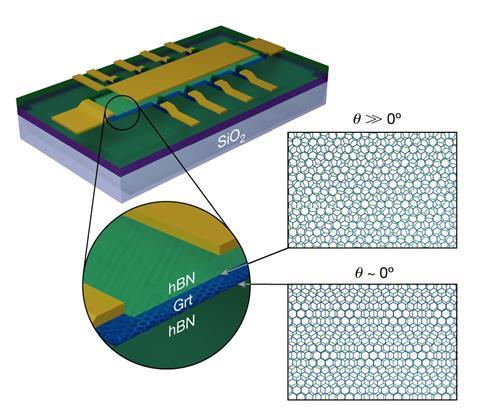
In fact researchers led by Fal’ko and Mishchenko simultaneously reported the same effect using a piece of graphite sandwiched between two crystals of hexagonal boron nitride, its slightly larger lattice spacing with respect to graphite yielding the moiré material effects.3 ‘This was entirely out of our expectations at first,’ says Mishchenko, describing their reaction to observing the Hofstadter butterfly in their graphite sample. He adds how they now see how it emerges from electrons spiralling between top and bottom graphite surfaces, ‘directed by strong magnetic fields and moiré effects’. People have taken an interest in graphite for thousands of years, but the arrival of graphene deflected attention from graphite for a while. These recent results, says Mishchenko ‘kind of brings back this life to graphite’.
References
1 A Uri et al, Nature, 2023, DOI: 10.1038/s41586-023-06294-z
2 D Waters et al, Nature, 2023, DOI: 10.1038/s41586-023-06290-3
3 C Mullan et al, Nature, 2023, DOI: 10.1038/s41586-023-06264-5



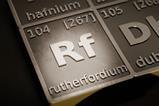



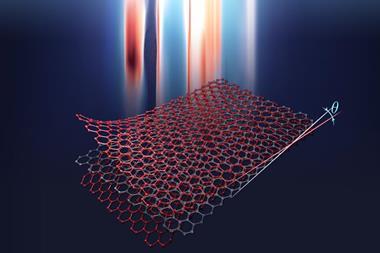









No comments yet